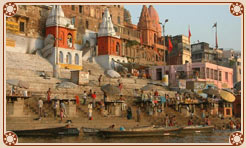Hindu Sanadhana Dharma shows very easy way to obtain salvation. 1. Visit the temples. 2. Take bath in holy rivers. 3. Study the vedas, ithihas and puranam when ever you get time and do Aradhana at your house and offer to your Lord the Prasadam before you take it.
Taking both in holy rivers like Ganga, Cauvery, Godhavari and other punya rivers is one advice given to us. While taking you the virtual tour of Divya desams we also take you to the above rivers for taking bath.
The top most priority is given for taking bath in Ganga especially at Kasi.
The legend says: Siva was affected with Brahma Hathi Dosha and after wandering many places he came to Kasi-which was the abode of Vishnu. The moment he entered this place His dosha vanished. Siva requested lord Vishnu to partake this place to Him.
This place is situated between the river Vara-which removes the sins of all and the river Nasi which removes the sins committed by our body- Hence this place is called Varanasi.
Varanasi (also known as Benares, Banaras, Kashi and Kasi) is a Hindu holy city on the banks of the Ganges River in the north Indian state of Uttar Pradesh.
Varanasi has a unique culture, quite different from other places in the region, and it is one of the major cultural centres of northern India.
Varanasi is the site of the holy shrine of Lord Kasi Viswanatha (a form of Lord Shiva) and is one of the revered 12 Jyotirlingas of the Lord.
Along with its positional advantage of being on the banks of the sacred Ganges River, this has given Varanasi a place at the forefront of the Hindu religion. Varanasi is considered the most sacred place for all Hindus, irrespective of denomination.
Hindus have long believed that bathing in the Ganges or dying in the holy city of Varanasi circumvents reincarnation and hence provides a permanent place in the Swarg (Heaven). This belief that has encouraged the establishment of innumerable nearby geriatric homes and also the disposal of half-burnt corpses into the river.
This latter practice continues to cause great damage to the river's ecology, but the ministry of water resources has finally taken up the restoration of the Ganga by banning cremation on the city's ghats (ghats are the banks of a holy river, stepped to facilitate bathing).
The Tulsi Ghat is famous for its association with the poet Tulsidas (C.E 1547-1623). The Asi Ghat, situated in the south at the union of the rivers Ganga and Asi is significant for the Surya Shashthhi festival. The Ganga Mahal Ghat is an extension of the Asi Ghat, and includes a palace built by the Maharaja of Benaras in 1830. The King of Rivan's palace stands at the Rivan Ghat, another extension of the Asi Ghat.
· The Bhadaini Ghat is one of the most ancient sacred sites in Varanasi that got its name from the famous sun shrine. Janki Ghat is named after the Queen of Sursund State, and the Anandmayi Ghat after Mother Anandmayi. Vaccharaja Ghat is a holy place for the Jain community, for it is close to the birthplace of the seventh Jain Tirthankara. Beside it is the Jain Ghat, which has two Jain temples on it. Nishadraj Ghat, named after Nisad, a mythical and heroic fisherman inRamayana, is a place for boatmen and fishermen.
· The Panchkoat Ghat was built by the king of Madhya Pradesh in 1915, and the Chet Singh Ghat was built by King Chet Singh, who fought a fierce battle against the British troops of Warren Hastings at this place. Niranjani Ghat has a historical connection with king Kumaragupta, and is famous for its Kartikeya temple.
· The Dasaswamedh Ghat is where Lord Brahma is said to have sacrificed ten horses in order to celebrate the return of Shiva on earth. Manikarnika Ghat is a sacred place for cremation.
· The Man Mandir Ghat was built in 1770 by Maharaja Jai Singh of Jaipur, and is known for its 'lingam' of Someshwar, the Lord of the Moon.
· Some of the other Ghats in Varanasi are the Maha Nirvani Ghat, Shivala Ghat, Gulariya Ghat, Dandi Ghat, Hanuman Ghat, Karnataka Ghat, Mansarover Ghat, Bachraj Ghat, Kedar Ghat, and the Lalita Ghat.
Varanasi Ghats
 Varanasi or Kashi is older than traditions. Varanasi presents a unique combination of physical, metaphysical and supernatural elements. According to the Hindu mythology, Varanasi liberates soul from human body to the ultimate. It is the Ganga Ghats of Varanasi that complement the concept of divinity. Ghats of Ganga are perhaps the holiest spots of Varanasi. The Ganga Ghats at Varanasi are full of pilgrims who flock to the place to take a dip in the holy Ganges, which is believed to absolve one from all sins.
Varanasi or Kashi is older than traditions. Varanasi presents a unique combination of physical, metaphysical and supernatural elements. According to the Hindu mythology, Varanasi liberates soul from human body to the ultimate. It is the Ganga Ghats of Varanasi that complement the concept of divinity. Ghats of Ganga are perhaps the holiest spots of Varanasi. The Ganga Ghats at Varanasi are full of pilgrims who flock to the place to take a dip in the holy Ganges, which is believed to absolve one from all sins.
There are number of temples on the bank of the Ganga river in Varanasi. It is believed that people are cleansed physically, mentally and spiritually at Ganga Ghats. It is at the Ganga Ghats where we see life and death together. For thousands of years people have been thronging these Ghats to offer their morning prayers to the rising sun.


No comments:
Post a Comment